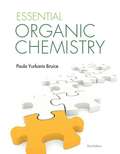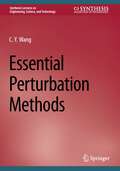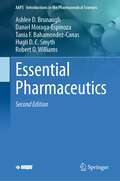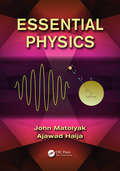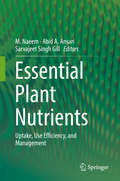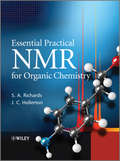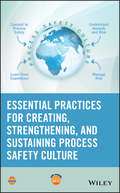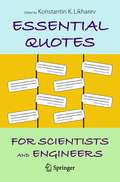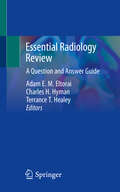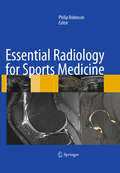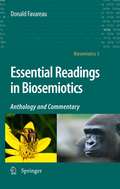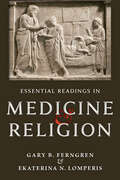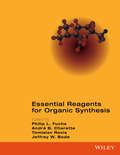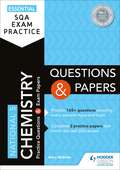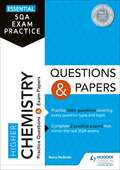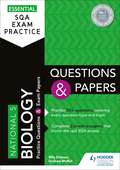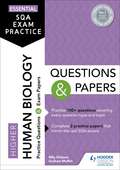- Table View
- List View
Essential Organic Chemistry, Third edition
by Paula Yurkanis BruiceA comprehensive, problem-solving approach for the brief Organic Chemistry course. Modern and thorough revisions to the streamlined, Essential Organic Chemistry focus on developing students’ problem solving and analytical reasoning skills throughout organic chemistry. Organized around reaction similarities and rich with contemporary biochemical connections, Bruice’s Third Edition discourages memorization and encourages students to be mindful of the fundamental reasoning behind organic reactivity: electrophiles react with nucleophiles.
Essential Perturbation Methods (Synthesis Lectures on Engineering, Science, and Technology)
by C.Y. WangThis book presents the modeling and scaling of physical problems, which result in normalized perturbation equations. This is followed by solving perturbation problems and evaluating the results. The author refines perturbation methods into simple, understandable elements and avoids unnecessary theorems and proofs. In addition, the results are consolidated and interpreted, and the presented examples are succinct to illustrate the essential techniques. This book is ideal and beneficial for practicing scientists and engineers who need to understand and apply perturbation methods to difficult problems with applications in mathematics, engineering, and biology. Discussions on new perspectives, simpler presentations on convergence, and the expansion of integrals are included.
Essential Pharmaceutics (AAPS Introductions in the Pharmaceutical Sciences #12)
by Robert O. Williams Ashlee D. Brunaugh Hugh D. Smyth Daniel Moraga-Espinoza Tania F. Bahamondez-CanasParticularly in healthcare fields, there is a growing movement away from traditional lecture style courses towards active learning and team-based activities to improve retention of concepts and build higher level thinking through the application of complex problems with a strong foundation of facts and data. Essential Pharmaceutics is suited to this modern teaching style and is the first book of its kind of provide the resources and skills needed for the successful implementation of an active learning basic pharmaceutics course. This text offers a format that is specifically suited for integration in an active learning, team-based classroom setting. It is ideal for self-learning for the beginning pharmaceutics student, based upon the extensive utilization of figures, tables, and its overview of essential topics in pharmaceutics. Essential Pharmaceutics provides the requisite foundational knowledge for the development and implementation of case studies based upon modern drug products.
Essential Physics
by John Matolyak Ajawad HaijaFluency with physics fundamentals and problem-solving has a collateral effect on students by enhancing their analytical reasoning skills. In a sense, physics is to intellectual pursuits what strength training is to sports. Designed for a two-semester algebra-based course, Essential Physics provides a thorough understanding of the fundamentals of ph
Essential Physiological Biochemistry
by Stephen ReedThis text provides a fresh, accessible introduction to human metabolism that shows how the physiological actions of selected organs can be explained by their particular biochemical processes. Focusing on metabolic integration, rather than pathways, this book opens with three introductory chapters that explore the principles of metabolism and its control before moving onto 'themed' chapters that investigate liver, communication systems (endocrine and neurological), blood and vascular system, muscle and adipose tissue and renal biochemistry. Targeted at non-biochemistry majors who need to get to grips with key biochemical concepts and ideas, this textbook is an essential guide for all undergraduate biomedical science, sports science, nutrition and other allied health students. Key features:A fresh, accessible primer that adopts a unique, organ-system based approach to human metabolism.Assumes only a basic understanding of chemistry.Chapters are arranged specifically to enable readers to grasp key concepts and to aid understanding.Some chapters include 'Case Notes, illustrating key aspects of metabolism in cells, tissues and organs.
Essential Plant Nutrients
by Sarvajeet Singh Gill M. Naeem Abid A. AnsariThis book explores the agricultural, commercial, and ecological future of plants in relation to mineral nutrition. It covers various topics regarding the role and importance of mineral nutrition in plants including essentiality, availability, applications, as well as their management and control strategies. Plants and plant products are increasingly important sources for the production of energy, biofuels, and biopolymers in order to replace the use of fossil fuels. The maximum genetic potential of plants can be realized successfully with a balanced mineral nutrients supply. This book explores efficient nutrient management strategies that tackle the over and under use of nutrients, check different kinds of losses from the system, and improve use efficiency of the plants. Applied and basic aspects of ecophysiology, biochemistry, and biotechnology have been adequately incorporated including pharmaceuticals and nutraceuticals, agronomical, breeding and plant protection parameters, propagation and nutrients managements. This book will serve not only as an excellent reference material but also as a practical guide for readers, cultivators, students, botanists, entrepreneurs, and farmers.
Essential Practical NMR for Organic Chemistry
by J. C. Hollerton S. A. RichardsThis book describes the use of NMR spectroscopy for dealing with problems of small organic molecule structural elucidation. It features a significant amount of vital chemical shift and coupling information but more importantly, it presents sound principles for the selection of the techniques relevant to the solving of particular types of problem, whilst stressing the importance of extracting the maximum available information from the simple 1-D proton experiment and of using this to plan subsequent experiments. Proton NMR is covered in detail, with a description of the fundamentals of the technique, the instrumentation and the data that it provides before going on to discuss optimal solvent selection and sample preparation. This is followed by a detailed study of each of the important classes of protons, breaking the spectrum up into regions (exchangeables, aromatics, heterocyclics, alkenes etc.). This is followed by consideration of the phenomena that we know can leave chemists struggling; chiral centres, restricted rotation, anisotropy, accidental equivalence, non-first-order spectra etc. Having explained the potential pitfalls that await the unwary, the book then goes on to devote chapters to the chemical techniques and the most useful instrumental ones that can be employed to combat them.A discussion is then presented on carbon-13 NMR, detailing its pros and cons and showing how it can be used in conjunction with proton NMR via the pivotal 2-D techniques (HSQC and HMBC) to yield vital structural information. Some of the more specialist techniques available are then discussed, i.e. flow NMR, solvent suppression, Magic Angle Spinning, etc. Other important nuclei are then discussed and useful data supplied. This is followed by a discussion of the neglected use of NMR as a tool for quantification and new techniques for this explained. The book then considers the safety aspects of NMR spectroscopy, reviewing NMR software for spectral prediction and data handling and concludes with a set of worked Q&As.
Essential Practical NMR for Organic Chemistry
by S. A. Richards J. C. HollertonEssential Practical NMR for Organic Chemistry A hands-on resource advocating an ordered approach to gathering and interpreting NMR data The second edition of Essential Practical NMR for Organic Chemistry delivers a pragmatic and accessible text demonstrating an ordered approach to gathering and interpreting NMR data. In this informal guide, you’ll learn to make sense of the high density of NMR information through the authors’ problem-solving strategies and interpretations. The book also discusses critical aspects of NMR theory, as well as data acquisition and processing strategy. It explains the use of NMR spectroscopy for dealing with problems of small organic molecule structural elucidation and includes a brand-new chapter on Nitrogen-15 NMR. Readers will also find: Strategies for preparing a sample, spectrum acquisition, processing, and interpreting your spectrum Fulsome discussions of Carbon-13 NMR spectroscopy Practical treatments of quantification, safety procedures, and relevant software An ideal handbook for anyone involved in using NMR to solve structural problems, this latest edition of Essential Practical NMR for Organic Chemistry will be particularly useful for chemists running and looking at their own NMR spectra, as well as those who work in small molecule NMR. It will also earn a place in the libraries of undergraduate and post-graduate organic chemistry students.
Essential Practices for Creating, Strengthening, and Sustaining Process Safety Culture
by CcpsAn essential guide that offers an understanding of and the practices needed to assess and strengthen process safety culture Essential Practices for Developing, Strengthening and Implementing Process Safety Culture presents a much-needed guide for understanding an organization's working culture and contains information on why a good culture is essential for safe, cost-effective, and high-quality operations. The text defines process safety culture and offers information on a safety culture’s history, organizational impact and benefits, and the role that leadership plays at all levels of an organization. In addition, the book outlines the core principles needed to assess and strengthen process safety culture such as: maintain a sense of vulnerability; combat normalization of deviance; establish an imperative for safety; perform valid, timely, hazard and risk assessments; ensure open and frank communications; learn and advance the culture. This important guide also reviews leadership standards within the organizational structure, warning signs of cultural degradation and remedies, as well as the importance of using diverse methods over time to assess culture. This vital resource: Provides an overview for understanding an organization's working culture Offers guidance on why a good culture is essential for safe, cost-effective, and high quality operations Includes down-to-earth advice for recognizing, assessing, strengthening and sustaining a good process safety culture Contains illustrative examples and cases studies, and references to literature, codes, and standards Written for corporate, business and line managers, engineers, and process safety professionals interested in excellent performance for their organization, Essential Practices for Developing, Strengthening and Implementing Process Safety Culture is the go-to reference for implementing and keeping in place a culture of safety.
Essential Quantum Mechanics for Electrical Engineers
by Peter DeákAuthored by a lecturer of quantum mechanics for students of electrical engineering and informatics for over 25 years, this textbook is scientifically sound and well-written, striking a balance between the formal mathematics necessary and informal prose. The introduction summarizes the basic concepts of classical physics and points out some of its failures, based on phenomena connected to lighting technology. These are analyzed in detail in the subsequent three chapters. Chapter 5 goes beyond the duality principle, and explains the particle concept of quantum mechanics and its consequences for electrical engineering, while chapters 6-8 introduce the mathematical construction used for describing the state of a particle and to predict its properties. The next two chapters present two examples of using this framework, with applications in light emitting diodes, infrared detectors, quantum cascade lasers, Zener diodes and flash memories. The final chapters then discuss some consequences of quantum mechanics for the chemical properties of atoms and for other many-electron systems, also providing a short insight into the potential hardware for quantum information processing. Among the host of didactic features are learning objectives, chapter summaries, self-testing questions, and problems with solutions, while the two appendices summarize the knowledge in classical physics and mathematics needed for this book.
Essential Quotes for Scientists and Engineers
by Konstantin K. LikharevThis book brings together about 2,500 quotations on various topics of interest to scientists and engineers, including students of STEM disciplines. Careful curation of the material by the editor provides the reader with far greater value than can be obtained by searching the internet.The quotes have been selected for various attributes including: importance of topic, depth of insight, and - not least - wit, with many of them satisfying all these criteria. To make sequential reading of the quotes more engaging, they are grouped into broad topical sections, and the entries within each section are organized thematically, forming quasi-continuous narrative threads. The text and authorship of each quote have been carefully verified, and the most popular cases of misquotation and misattribution are noted. The book represents a valuable resource for those writing science and engineering articles as well as being a joy to read in its own right.
Essential Radiology Review: A Question and Answer Guide
by Adam E. M. Eltorai Charles H. Hyman Terrance T. HealeyThe book is an on-the-spot reference for residents and medical students seeking diagnostic radiology fast facts. Its question-and-answer format makes it a perfect quick-reference for personal review and studying for board examinations and re-certification. Readers can read the text from cover to cover to gain a general foundation of knowledge that can be built upon through practice or can use choice chapters to review a specific subspecialty before starting a new rotation or joining a new service. With hundreds of high-yield questions and answer items, this resource addresses both general and subspecialty topics and provides accurate, on-the-spot answers. Sections are organized by subspecialty and body area, including chest, abdomen, and trauma, and chapters cover the anatomy, pathophysiology, differential diagnosis, hallmark signs, and image features of major diseases and conditions. Key example images and illustrations enhance the text throughout and provide an ideal, pocket-sized resource for residents and medical students.
Essential Radiology for Sports Medicine
by Philip RobinsonThis highly illustrated, practical book provides a systematic approach to all significant sports injuries. Imaging features are presented along with discussion of the influence of these findings on treatment and image-guided interventions. For each anatomical area, the underlying biomechanical features that produce injury are explored. All imaging modalities are featured with emphasis on MRI, MR arthrography, CT, and ultrasound. A concise guide to sports injuries, this book will help clinicians identify the appropriate imaging techniques and treatments to best serve their patients. This up-to-date resource is an excellent, high-yield resource for radiologists, emergency radiologists, orthopedists, and sports medicine professionals. International experts provide guidance as to how sports injuries occur and how to recognize relevant imaging findings.
Essential Readings in Biosemiotics
by Donald FavareauSynthesizing the findings from a wide range of disciplines - from biology and anthropology to philosophy and linguistics - the emerging field of Biosemiotics explores the highly complex phenomenon of sign processing in living systems. Seeking to advance a naturalistic understanding of the evolution and development of sign-dependent life processes, contemporary biosemiotic theory offers important new conceptual tools for the scientific understanding of mind and meaning, for the development of artificial intelligence, and for the ongoing research into the rich diversity of non-verbal human, animal and biological communication processes. Donald Favareau's Essential Readings in Biosemiotics has been designed as a single-source overview of the major works informing this new interdiscipline, and provides scholarly historical and analytical commentary on each of the texts presented. The first of its kind, this book constitutes a valuable resource to both bioscientists and to semioticians interested in this emerging new discipline, and can function as a primary textbook for students in biosemiotics, as well. Moreover, because of its inherently interdisciplinary nature and its focus on the 'big questions' of cognition, meaning and evolutionary biology, this volume should be of interest to anyone working in the fields of cognitive science, theoretical biology, philosophy of mind, evolutionary psychology, communication studies or the history and philosophy of science.
Essential Readings in Medicine & Religion
by Gary B. Ferngren Ekaterina N. Lomperis“[A] useful, well-edited anthology of important texts in the history of the intersection of religion and medicine.” —Warren Kinghorn, MD, ThD, Duke University Medical Center and Duke Divinity SchoolGary B. Ferngren and Ekaterina N. Lomperis have gathered a rich collection of annotated primary sources that illustrate the intersection of medicine and religion. Intended as a companion volume to Ferngren’s classic Medicine and Religion, which traces the history of the relationship of medicine to religion in the Western world from the earliest ancient Near Eastern societies to the twenty-first century, this useful and extensive sourcebook places each key document in historical context.Drawing from more than 160 texts, the book explores a number of themes, including concepts of health, the causes and cure of disease, medical ethics, theodicy, beneficence, religious healing, consolation, and death and dying. Each chapter begins with an introduction that furnishes a basic historical setting for the period covered. Modern translations, some of which have been made especially for this volume, are used whenever possible. The texts are numbered sequentially within each chapter and preceded by a short introduction to both the author and the subject.Touching on Mesopotamia, Egypt, Israel, Greece, Rome, the European Middle Ages, Islam, early modern Europe, and the modern era, Essential Readings in Medicine and Religion brings a wide range of sources together to expand on the crucial lessons of Medicine and Religion. This book is a useful introduction for all students of history, divinity, medicine, and health.
Essential Readings in Medicine and Religion
by Gary B. Ferngren Ekaterina N. LomperisAn indispensible collection of sources chronicling the relationship between medicine and religion from ancient to modern times.Gary B. Ferngren and Ekaterina N. Lomperis have gathered a rich collection of annotated primary sources that illustrate the intersection of medicine and religion. Intended as a companion volume to Ferngren’s classic Medicine and Religion, which traces the history of the relationship of medicine to religion in the Western world from the earliest ancient Near Eastern societies to the twenty-first century, this useful and extensive sourcebook places each key document in historical context.Drawing from more than 160 texts, the book explores a number of themes, including concepts of health, the causes and cure of disease, medical ethics, theodicy, beneficence, religious healing, consolation, and death and dying. Each chapter begins with an introduction that furnishes a basic historical setting for the period covered. Modern translations, some of which have been made especially for this volume, are used whenever possible. The texts are numbered sequentially within each chapter and preceded by a short introduction to both the author and the subject.Touching on Mesopotamia, Egypt, Israel, Greece, Rome, the European Middle Ages, Islam, early modern Europe, and the modern era, Essential Readings in Medicine and Religion brings a wide range of sources together to expand on the crucial lessons of Medicine and Religion. This book is a useful introduction for all students of history, divinity, medicine, and health.
Essential Reagents for Organic Synthesis
by Philip L. Fuchs Jeffrey W. Bode André B. Charette Tomislav RovisFrom Boron Trifluoride to Zinc, the 52 most widely used reagents in organic synthesis are described in this unique desktop reference for every organic chemist. The list of reagents contains classics such as N-Bromosuccinimide (NBS) and Trifluoromethanesulfonic Acid side by side with recently developed ones like Pinacolborane and Tetra-n-propylammonium Perruthenate (TPAP). For each reagent, a concise article provides a brief description of all important reactions for which the reagent is being used, including yields and reaction conditions, an overview of the physical properties of the reagent, its storage conditions, safe handling, laboratory synthesis and purification methods. Advantages and disadvantages of the reagent compared to alternative synthesis methods are also discussed. Reagents have been hand-picked from among the 5000 reagents contained in EROS, the Encyclopedia of Reagents for Organic Synthesis. Every organic chemist should be familiar with these key reagents that can make almost every reaction work.
Essential Relativistic Celestial Mechanics
by Victor BrumbergEssential Relativistic Celestial Mechanics presents a systematic exposition of the essential questions of relativistic celestial mechanics and their relation to relativistic astrometry. The book focuses on the comparison of calculated and measurable quantities that is of paramount importance in using general relativity as a necessary framework in the discussion of high-precision observations and for the construction of accurate dynamical ephemerides. It discusses the results of the general relativistic theory of motion of celestial bodies and describes the relativistic theory of astronomical reference frames, time scales, and the reduction of observations.
Essential SQA Exam Practice: From the publisher of How to Pass
by Barry McBrideExam board: SQALevel: National 5Subject: ChemistryFirst teaching: September 2017First exam: Summer 2018Practice makes permanent. Feel confident and prepared for the SQA National 5 Chemistry exam with this two-in-one book, containing practice questions for every question type and topic, plus two full practice papers.- Choose to revise by question type or topic: A simple grid enables you to pick particular question styles or course areas that you want to focus on, with answers provided at the back of the book- Understand what the examiner is looking for: Clear guidance on how to answer each question type is followed by plenty of questions so you can put the advice into practice, building essential exam skills- Remember more in your exam: Repeated and extended practice will give you a secure knowledge of the key areas of the course (chemical changes and structure; nature's chemistry; chemistry in society)- Familiarise yourself with the exam paper: Both practice papers mirror the language and layout of the real SQA papers; complete them in timed, exam-style conditions to increase your confidence before the exams- Find out how to achieve a better grade: Answers to the practice papers have commentaries for each question, with tips on writing successful answers and avoiding common mistakesFully up to date with SQA's requirementsThe questions, mark schemes and guidance in this practice book match the requirements of the revised SQA National 5 Chemistry specification for examination from 2018 onwards.
Essential SQA Exam Practice: From the publisher of How to Pass
by Barry McBrideExam board: SQALevel: HigherSubject: ChemistryFirst teaching: September 2018First exam: Summer 2019Practice makes permanent. Feel confident and prepared for the SQA Higher Chemistry exam with this two-in-one book, containing practice questions for every question type and topic, plus two full practice papers.- Choose to revise by question type or topic: A simple grid enables you to pick particular question styles or course areas that you want to focus on, with answers provided at the back of the book- Understand what the examiner is looking for: Clear guidance on how to answer each question type is followed by plenty of questions so you can put the advice into practice, building essential exam skills- Remember more in your exam: Repeated and extended practice will give you a secure knowledge of the key areas of the course (chemical changes and structure; nature's chemistry; chemistry in society; researching chemistry)- Familiarise yourself with the exam papers: Both practice papers mirror the language and layout of the real SQA papers; complete them in timed, exam-style conditions to increase your confidence before the exams- Find out how to achieve a better grade: Answers to the practice papers have commentaries for each question, with tips on writing successful answers and avoiding common mistakesFully up to date with SQA's requirementsThe questions, mark schemes and guidance in this practice book match the requirements of the revised SQA Higher Chemistry specification for examination from 2019 onwards.
Essential SQA Exam Practice: From the publisher of How to Pass
by Graham Moffat Billy DicksonExam board: SQALevel: National 5Subject: BiologyFirst teaching: September 2017First exam: Summer 2018Practice makes permanent. Feel confident and prepared for the SQA National 5 Biology exam with this two-in-one book, containing practice questions for every question type and topic, plus two full practice papers - all written by experienced examiners.- Choose to revise by question type or topic: A simple grid enables you to pick particular question styles or course areas that you want to focus on, with answers provided at the back of the book- Understand what the examiner is looking for: Clear guidance on how to answer each question type is followed by plenty of questions so you can put the advice into practice, building essential exam skills- Remember more in your exam: Repeated and extended practice will give you a secure knowledge of the key areas of the course (cell biology; biology: multicellular organisms; biology: life on Earth)- Familiarise yourself with the exam paper: Both practice papers mirror the language and layout of the real SQA papers; complete them in timed, exam-style conditions to increase your confidence before the exams- Find out how to achieve a better grade: Answers to the practice papers have commentaries for each question, with tips on writing successful answers and avoiding common mistakesFully up to date with SQA's requirementsThe questions, mark schemes and guidance in this practice book match the requirements of the revised SQA National 5 Biology specification for examination from 2018 onwards.
Essential SQA Exam Practice: From the publisher of How to Pass
by Graham Moffat Billy DicksonExam board: SQALevel: HigherSubject: BiologyFirst teaching: September 2018First exam: Summer 2019Practice makes permanent. Feel confident and prepared for the SQA Higher Biology exam with this two-in-one book, containing practice questions for every question type and topic, plus two full practice papers - all written by experienced examiners.- Choose to revise by question type or topic: A simple grid enables you to pick particular question styles or course areas that you want to focus on, with answers provided at the back of the book- Understand what the examiner is looking for: Clear guidance on how to answer each question type is followed by plenty of questions so you can put the advice into practice, building essential exam skills- Remember more in your exam: Repeated and extended practice will give you a secure knowledge of the key areas of the course (DNA and the genome; metabolism and survival; sustainability and interdependence)- Familiarise yourself with the exam papers: Both practice papers mirror the language and layout of the real SQA papers; complete them in timed, exam-style conditions to increase your confidence before the exams- Find out how to achieve a better grade: Answers to the practice papers have commentaries for each question, with tips on writing successful answers and avoiding common mistakesFully up to date with SQA's requirementsThe questions, mark schemes and guidance in this practice book match the requirements of the revised SQA Higher Biology specification for examination from 2019 onwards.
Essential SQA Exam Practice: From the publisher of How to Pass
by Graham Moffat Billy DicksonExam board: SQALevel: HigherSubject: Human BiologyFirst teaching: September 2018First exam: Summer 2019Practice makes permanent. Feel confident and prepared for the SQA Higher Human Biology exam with this two-in-one book, containing practice questions for every question type and topic, plus two full practice papers - all written by experienced examiners.- Choose to revise by question type or topic: A simple grid enables you to pick particular question styles or course areas that you want to focus on, with answers provided at the back of the book- Understand what the examiner is looking for: Clear guidance on how to answer each question type is followed by plenty of questions so you can put the advice into practice, building essential exam skills- Remember more in your exam: Repeated and extended practice will give you a secure knowledge of the key areas of the course (human cells; physiology and health; neurobiology and immunology)- Familiarise yourself with the exam papers: Both practice papers mirror the language and layout of the real SQA papers; complete them in timed, exam-style conditions to increase your confidence before the exams- Find out how to achieve a better grade: Answers to the practice papers have commentaries for each question, with tips on writing successful answers and avoiding common mistakesFully up to date with SQA's requirementsThe questions, mark schemes and guidance in this practice book match the requirements of the revised SQA Higher Human Biology specification for examination from 2019 onwards.
